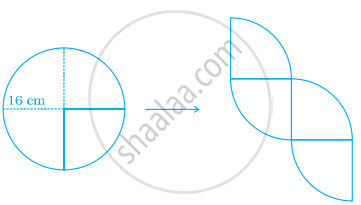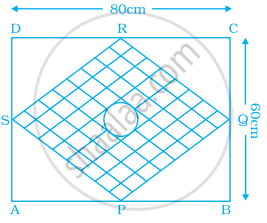Advertisements
Advertisements
Question
Is it true that the distance travelled by a circular wheel of diameter d cm in one revolution is 2 π d cm? Why?
Solution
Distance travelled by a circular wheel of radius r in one revolution equals the circumference of the circle.
We know that,
Circumference of the circle = 2πd; where d is the diameter of the circle.
Thus, it is not true that the distance travelled by a circular wheel of diameter d cm in one revolution is 2 d cm.
APPEARS IN
RELATED QUESTIONS
In Fig. there are shown sectors of two concentric circles of radii 7 cm and 3.5 cm. Find the area of the shaded region. Use π = `(\frac { 22 }{ 7 }).`
A boy is cycling in such a way that the wheels of his bicycle are making 140 revolutions per minute. If the diameter of a wheel is 60 cm, calculate the speed (in km/h) at which the boy is cycling.
The circumference of a circle is equal to the perimeter of a square. The area of the square is 484 sq. m. Find the area of the circle.
Find the volume and the surface area of the spheres in the following :
Radius = 7 cm
Using a ruler and compasses only:
(i) Construct a triangle ABC with the following data: AB = 3.5 cm, BC = 6 cm and ∠ ABC = 120°.
(ii) In the same diagram, draw a circle with BC as diameter. Find a point P on the circumference of the circle which is equidistant from AB and BC.
(iii) Measure ∠ BCP.
A bucket is raised from a well by means of a rope wound round a wheel of diameter 35 cm. If the bucket ascends in 2 minutes with a uniform speed of 1.1 m per sec, calculate the number of complete revolutions the wheel makes in raising the bucket.
Circumferences of two circles are equal. Is it necessary that their areas be equal? Why?
A circle with radius 16 cm is cut into four equal parts and rearranged to form another shape as shown in the below figure:

Does the perimeter change? If it does change, by how much does it increase or decrease?
ABCD is a given rectangle with length as 80 cm and breadth as 60 cm. P, Q, R, S are the midpoints of sides AB, BC, CD, DA respectively. A circular rangoli of radius 10 cm is drawn at the centre as shown in the given figure. Find the area of shaded portion.

